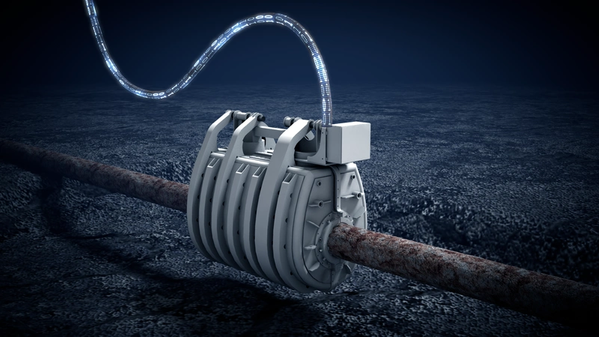A Norwegian robotics firm called Kongsberg Ferrotech, which creates subsea robots for the oil and gas industry, is developing a form of underwater 3D printing for repairing pipelines below the sea. To develop the process, known as “Subsea Additive Manufacturing for Lifetime Extension”, the company is working with Equinor, SINTEF, and Gassco.
Kongsberg Ferrotech offers several robots that perform inspection, repair and maintenance (IRM) of subsea equipment. This includes a system called Nautilus, which remotely repairs pipelines using composite materials. Nautilus has passed deepwater testing in the Trondheim Fjord in Norway and the company plans to begin commercial operations in the Southeast Asian market in Q3 20201. Footage of how this process works can be seen in the video below:
Under the Research Council of Norway’s PETROMAKS 2 program, the firm would build upon that technology to repair metal structures in a layer-by-layer fashion. Kongsberg Ferrotech’s robots are able to perform repairs and modifications in a dry environment while completely submerged, doing so in a single operation and without divers or conventional equipment. One would expect that the type of metal 3D printing involved to be some form of directed energy deposition, with an arc-welding style printhead used to fuse metal wire onto the surface of a pipe.
“The rapid development of 3D printing technology is creating new opportunities and markets going forward,” says Brede Lærum, head of 3D printing at Equinor, the Norwegian state-owned oil and gas company. “Combining this technology with Kongsberg Ferrotech’s robots opens many exciting new possibilities for subsea repairs and modifications. We are looking forward to a close collaboration with our industry partners.”
“This is the start of a new industrial adventure that is of strategic importance to our company. We see a large long-term market opportunity also beyond the oil and gas industry,” says Christopher Carlsen, CEO at Kongsberg Ferrotech. “The collaboration with Equinor, Gassco, and SINTEF represents world-class expertise within operations of underwater installations, underwater transport systems, and research on metallic repair processes. This unique opportunity to develop underwater 3D printing for lifetime extension is an important technology leap – not only for Kongsberg Ferrotech but also for the industry.”
In addition to Equinor, the country’s natural gas firm, Gassco, and the independent SINTEF research organization will participate in the project. Because the Norwegian shelf has more than 10,000 km of subsea pipelines, there is obviously a need to repair these as they age or experience damage. As glaciers in the Arctic melt as a result of global warming, a fight for oil and gas projects in the region is anticipated, as well. Of course, climate change should be more of a reason to retire existing oil and gas infrastructure, but the Norwegian government obviously has financial reasons for maintaining it.

A rendering of the Nautilus robot developed by Kongsberg Ferrotech. Image courtesy of Kongsberg Ferrotech.
Both maritime and oil and gas are sectors that have been unexplored in 3D printing, but could be disrupted with the technology. In the former, the industry is basically being led by Wilhelmsen and its associates. In the latter, most of the oil majors have experimented with the technology for end parts in one way or another. GE Oil & Gas is among the most far along here, perhaps due to the larger conglomerate’s expertise in mass production of 3D printed parts in aerospace.
There is plenty of room for overlap in these two highly related industries and Kongsberg Ferrotech has found it. If we’re going to continue to using fossil fuels, it is obviously crucial that we keep pipelines in tact so as to prevent the dumping of toxic materials into the world’s oceans. The Norwegian firm believes that it will see the first use of an underwater 3D printing robot in 2022.
Subscribe to Our Email Newsletter
Stay up-to-date on all the latest news from the 3D printing industry and receive information and offers from third party vendors.
You May Also Like
IperionX Inks 10-Year Deal with Wisconsin Manufacturer for 80 Metric Tons of Titanium Per Year
IperionX, the Charlotte-based supplier of sustainable titanium powders used for additive manufacturing (AM) and metal injection molding (MIM), has signed a ten-year deal with United Stars, a group of industrial...
Gastronology Launches Industrial Production of 3D Printed Food for Dysphagia Patients
Food 3D printing has, in many ways, been an additive manufacturing (AM) segment looking for the right business case. While some applications are beautiful and others may or may not...
Lockheed Martin Leads $3M Investment in Q5D’s Electronics 3D Printing System
Q5D, an original equipment manufacturer (OEM) of robotic arm, hybrid additive manufacturing (AM) systems used for wire harness production, has closed a $3 million investment round. The investment arm of...
3D Printing News Briefs, April 6, 2024: Depowdering, Cybertruck Door Handles, & More
In today’s 3D Printing News Briefs, ioTech’s digital manufacturing CLAD technology is opening up opportunities for microelectronics and additive manufacturing. Hexagon and Raytheon Technologies commercially released the Simufact Additive Process...































